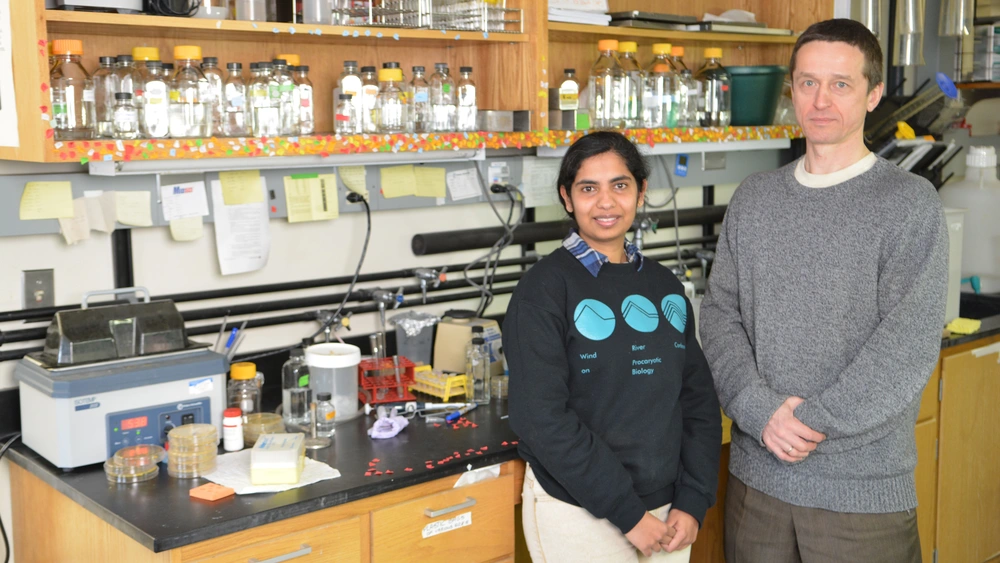
The latest paper by the Kuzminov lab investigates the mechanism of thymineless death, which is a common mode of action of anti-cancer and anti-bacterial drugs. The findings were published in a paper titled "Sources of thymidine and analogs fueling futile damage-repair cycles and ss-gap accumulation during thymine starvation in Escherichia coli" in DNA Repair.
Death from thymine starvation is a universal phenomenon. Drugs such as trimethoprim and methotrexate cause thymine starvation and are lethal to fast-growing cells. Therefore, they are used to treat bacterial infections and cancer. Despite the medical importance of thymineless death, the mechanisms of killing remain unclear.
Thymine is incorporated into the DNA in the form of thymidine. During thymine starvation replication stalls, and it is believed that the partially replicated DNA is then somehow damaged to a state that cannot be fixed even when thymine becomes available again. Several mechanisms have been proposed for the killing, but there is no consensus in the field. In the study, the Kuzminov lab has tested several of the proposed mechanisms and found a new physical readout that correlates with killing.
Thymine starvation can be initiated in E. coli by withdrawing thymine from cells that lack the ability to synthesize it. During starvation, cells remain fully viable for about an hour which is known as the resistance phase. After this phase, the viability plunges, so that only about 0.1% of the cells remain alive after 4 hours. Under physiological conditions, it is likely that the resistance phase lasts for several hours. Therefore, it is important to understand the processes that occur during the initial resistance phase in order to enhance treatments. The lab investigated what factors contribute to the resistance phase and the transition to the death phase.
During the resistance phase the cell might be able to stabilize its chromosome by finding an internal source of thymidine. "We hypothesized that since there are several branches of replication that occur simultaneously in the cell, the secondary branches are completely degraded to derive thymidine for the remaining chromosomal DNA," explained Dr. Andrei Kuzminov, Professor in the Department of Microbiology. "In support of this logic, we saw evidence of DNA fragmentation during the resistance phase, after which the fragments disappeared, and the cells entered the death phase," added Kuzminov.
To test whether DNA fragmentation provides thymidine during the resistance phase, Pritha Rao, a graduate student in the Kuzminov lab, used mutants in which the broken DNA remains stable and does not get degraded. The prediction was that these mutants would not have a resistance phase. However, the results did not agree. "We see that the death phase becomes faster but the resistance phase is unaffected, indicating that deriving thymidine by DNA degradation does not help," said Rao.
They then explored a second idea. "According to the literature, stable RNA such as rRNA and tRNA contain thymine groups. Since we see DNA replication in the resistance phase, we thought that these thymines are released and incorporated into DNA," explained Rao. "We have shown that during the late thymine starvation periods the tRNA and rRNA become destabilized. They release thymine, which supports viability." Kuzminov added, "We believe that 1 out of 1000 cells use this strategy to escape thymineless death. However, for the majority of the cells, the DNA replication during resistance phase is not due to the release of thymine from these stable RNAs." Therefore, the source of thymidine that supports the chromosomal DNA during the resistance phase remains unknown.
The lab also investigated the nature of the lethality associated with thymine starvation. "One popular hypothesis was that cells incorporate deoxyuridine (dU) in DNA when they lack thymidine. However, the incorporated dU is then excised by repair enzymes. This repeated incorporation and excision is thought to make the DNA unstable, causing cell death," said Rao. To test this hypothesis, she made mutants which lacked the enzymes responsible for excision, making DNA-dU stable. "We saw no change in cell viability during thymine starvation. We also increased the dU pool in the cells without DNA-dU excision. The cells were able to finish two rounds of chromosomal replication, but still died. These are the first experiments that show that the cause of thymineless death may be independent of chromosomal replication."
The lab is still searching for the mechanisms of thymineless death. They have shown that the cells accumulate single stranded gaps in the DNA. Repairing these gaps becomes detrimental as thymine starvation progresses. However, it is still unclear why these single stranded gaps accumulate in such large amounts, and how their repair kills the cell. "We have eliminated several causes of lethality, but the cells still continue to die. It's as if they become suicidal," said Rao.
